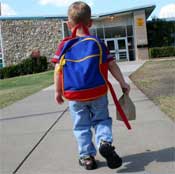
As Science News reports this week, researchers including UBC’s Lawrence Frank (whose work we covered in Cascadia Scorecard 2006) are finding that children are disproportionately affected by how their neighborhood is designed. In one study of what determines whether kids are active, scientists found that:
Girls who live near parks and recreational facilities are more physically active than those whose neighborhoods contain no such spaces, the researchers found. . . . Each park within a half-mile of home contributed an extra 17.2 minutes of vigorous activity per girl over the course of the study.
This isn’t terribly suprising, of course, but it’s heartening to know that better, safer neighborhood design will especially benefit the youngest members of the population.
The inverse is true as well, of course: A new study on the effects of traffic pollution on kids—-the largest of its kind– finds that:
Children living near busy highways have significant impairments in the development of their lungs that can lead to respiratory problems for the rest of their lives.
Yoiks! (As Clark would say.)
All the researchers conceded that there is little that can be done to mitigate the effects of the traffic pollution now. . . . But when local governments are planning new schools and new housing developments, Gauderman said, “this should be taken into account.”
P.S. A last interesting nugget from Frank’s research: A question that’s dogged researchers on healthy community design has been sorting out the self-sorting effect.
Are people who live in compact, walkable neighborhoods more active because they seek out neighborhoods that “match” their lifestyle? Turns out that even though self-sorting occurs, where you live still affects your habits.
By surveying people in a variety of neighborhoods, [Frank] learned that people who are less inclined to be active tend to live in less pedestrian-friendly locales—evidence that people are sorting themselves. But he also found that, no matter how much people like or dislike being active, they are more active when they live in compact, walkable areas than when they live in sprawling neighborhoods.
So even for a self-defined couch potato (a group I’ve joined this bleak winter), factors such as connected streets and stores within walking distance add up.







lesgldst
You write that “Each park within a half-mile of home contributed an extra 17.2 minutes of vigorous activity per girl over the course of the study”. Was the length of the study a year, an hour, or something else? Believe it or not, the length of the study does matter.